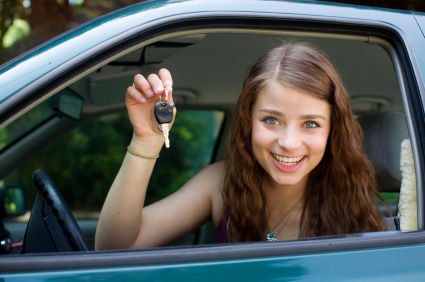New Study Finds Teens Have Risky Definitions of "Safe Driving"
 |
BOSTON--March 18, 2014: Teens know that drinking or using a cell phone while driving are dangerous behaviors – that's no surprise. What is surprising is that according to a new survey from Liberty Mutual Insurance and SADD (Students Against Destructive Decisions), teens seem to have a different definition of what it actually means to engage in these potentially deadly behaviors. From drinking or texting while driving to using a designated driver, the new survey highlights a sharp disconnect between what teens acknowledge as risky behavior and what they actually admit to doing behind the wheel.
What is "Under the Influence"? According to the survey results, teens claim to understand the dangers surrounding drinking and driving:
The majority (86 percent) of teen drivers consider driving under the influence of alcohol to be extremely or very distracting Only 1 percent of teens define driving under the influence of alcohol as acceptable Only 5 percent of teens admit to at least sometimes driving under the influence of alcohol
However, when asked about actual driving behavior involving alcohol, driving "under the influence" takes on a different definition:
One in 10 teens who say they never drive under the influence acknowledge that they occasionally drive after having an alcoholic beverage More than two-thirds of teens (68 percent) who admit to driving under the influence of alcohol say they have done so after having more than three alcoholic beverages
According to the National Highway Traffic Safety Administration, with a quarter of fatal crashes involving young drivers resulting from drinking and driving, these statistics are a reminder that even one drink can be too many.
"While many teens seem to have gotten the message about these driving dangers, the real challenge is to make sure they understand that even a sip of alcohol or a quick text at a red light can be deadly," said David Melton, driving safety expert with Liberty Mutual Insurance and managing director of global safety. "Teens need to realize it's not acceptable to put an allowable limit to their engagement in these behaviors – they need to be eliminated entirely when they are behind the wheel."
Defining "Designated" While underage drinking is never acceptable and always illegal, many teens and parents consider a designated driver to be a safe alternative to impaired driving. In fact, more than half of parents (58 percent) encourage teens to use designated drivers to avoid driving under the influence, and almost half of teens (47 percent) admit to using one.
However, teens' definitions of "designated" are concerning:
Designated Means "Basically Sober": 21 percent of teens define their designated driver as allowed to have "a little" alcohol or other drugs, as long as they aren't too impaired to drive Designated Means "Least Impaired": 4 percent of teens describe their designated driver as the "most" sober person in the group
"With teens reporting these lax definitions of what it means to be 'under the influence,' a zero tolerance approach is the only answer to prevent potential tragedy," said Stephen Gray Wallace, senior advisor for policy, research and education at SADD. "The parents and community have a responsibility to initiate and maintain an open dialogue with teens about exactly what driving under the influence means."
Talking and Texting Behind the Wheel According to the U.S. Department of Transportation, more than 3,300 deaths were reported in 2012 alone as the result of distracted driving, many attributed to talking or texting on a cell phone. Teens seem to understand the dangers of these behaviors:
Nearly all (96 percent) teen drivers understand that using a cell phone while driving – either talking or texting – is at least slightly distracting 62 percent of teen drivers think texting and driving is extremely or very distracting
However, according to the new data, teen drivers often do not grasp the dangers of what it actually means to use a phone while driving:
The majority of teen drivers (86 percent) still admit to using a cell phone behind the wheel Nearly half (47 percent) of the teen drivers who say they never text while driving still admit to texting at a red light or stop sign 68 percent of teen drivers admit to reading or replying to text messages while driving
"It's critical not only for teens, but all drivers to understand that any time you pull out your phone when you are driving, whether you're moving or at a stoplight, your attention is diverted and you put yourself, passengers and others on the road at risk," said Melton. "If you need to use your phone while driving, find a safe place to pull off the road to make a call or send a text. It's not worth the risk to respond at a stop sign or before the light turns green."
Open Discussions Among Parents and Teens Liberty Mutual Insurance and SADD encourage parents to have conversations with their teens about responsible driving and to sign a Parent/Teen Driving Contract. The customized agreement enables parents to create and uphold family driving rules. For more information about safe teen driving and to download a contract, visit TeenDriving.
About the Study Liberty Mutual Insurance and SADD commissioned ORC International to conduct a qualitative and quantitative methodology to measure teen driving attitudes and behaviors. The study was initiated with a series of focus groups held in Philadelphia, Pa., and Dallas, Texas from May 29 – May 30, 2013, followed by a survey of 2,537 eleventh and twelfth graders from across the country. Overall the findings from the study can be interpreted at a 95 percent confidence interval with an error margin of +/- 1.68 percent. Error margins for subsets such as licensed drivers will be wider. Additionally, the study surveyed 1,000 parents of high school aged teenage drivers, providing an overall error margin of +/- 2.94 percent.


